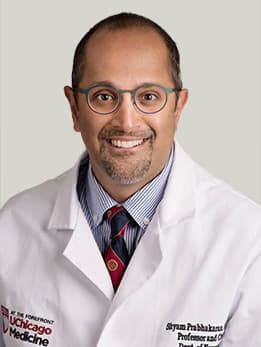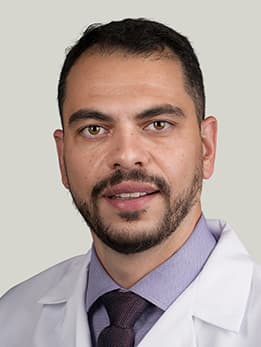Study finds recent change in EMS transport policy could improve stroke outcomes

Patients with a suspected acute ischemic stroke who are taken by emergency medical services (EMS) directly to comprehensive stroke centers rather than the nearest stroke center for care are more likely to receive endovascular therapy, according to research led by investigators at the University of Chicago Medicine, in collaboration with local healthcare and emergency response groups.
The study underscores the importance of a regional policy that has guided EMS response in Chicago to a suspected stroke since 2018 — which the researchers say will lead to improved outcomes for patients. The results were published on August 9 in Shyam Prabhakaran, MD, Professor and Chair of Neurology at UChicago Medicine, and the study’s senior author. “We are one of the first regions in the United States to implement this kind of tiered policy for stroke.”
Several years ago, the American Heart Association issued a recommendation that patients suspected by EMS to have a large vessel occlusion be transported to the nearest comprehensive stroke center, as long as it was within a reasonable distance. Evidence has shown that comprehensive stroke centers provide critical treatments that improve outcomes for patients with large vessel occlusions, or blocked arteries, which account for most of the disabling strokes.
Following this recommendation, hospitals and emergency services in the city of Chicago worked together to develop a new regional policy to guide the EMS response to a suspected stroke.
The UChicago Medicine-led team of researchers decided to use implementation of the policy in 2018 to better understand how the policy change affected stroke care. The team included a variety of collaborators from the University of Chicago, Northwestern University, the Chicago EMS system, Advocate Illinois Masonic Medical Center, the Cook County Health Department of Emergency Medicine, and the American Heart Association.
“It is really tragic when an ischemic stroke patient gets delayed care. Time is brain: the minutes and hours that are lost when a patient has to be transferred from one hospital to another can’t be regained, which often leads to worse outcomes,” said Prabhakaran. “Systems of care like ours in Chicago have developed protocols to identify stroke patients based on stroke severity in the field and move them to the right hospital. Now, we’re one of the first to have implemented such a system and studied its effect.”
The policy provides a set of guidelines for EMS to rapidly evaluate potential stroke patients and, depending on the results and the location of the call, the response team can choose to transport the patient directly to a comprehensive stroke center, rather than a primary stroke center. This is important because certain treatments for acute ischemic strokes — such as endovascular therapy, an important treatment for large vessel occlusion — are only available at comprehensive stroke centers.
Endovascular therapy (EVT) involves threading tiny catheters through blood vessels in the groin or the wrist to the location of the blood clot causing the large vessel occlusion. The blood clot can then be removed using devices such as stents or aspiration catheters, in a procedure known as a thrombectomy, or dissolved using medications in a process called thrombolysis.
In the study, the researchers found that when EMS used a three-item stroke scale to quickly evaluate patients and direct those with a suspected large vessel occlusion directly to comprehensive stroke centers, there was a rapid increase in the number of patients who received EVT. Importantly, nearly three times as many patients received EVT after the new protocol was implemented compared to before. While the study did not look directly at patient outcomes, the investigators say that these results are promising.
“We know that the ischemic brain ages physiologically several years every hour treatment is delayed and that providing EVT reduces disability and death in patients by almost 20%,” said lead author Tareq Kass-Hout, MD, Assistant Professor and director of Endovascular Neurology at UChicago Medicine. “Since this treatment improves outcomes and policy changes such as ours increases the delivery of this powerful treatment, it is imperative that other regions also consider ways to implement routing policies to direct stroke patients to the appropriate stroke center. By doing this, there will be a major public health impact, because we know that the more EVT is used in a population, the more people are saved from disability and death.”
Prabhakaran hopes the study will inspire other regions to develop similar policies — and help Chicago patients understand that they can trust the response by EMS and need to react quickly when experiencing a stroke.
“Many people don’t realize that a stroke is an emergency that needs to be taken care of immediately,” said Prabhakaran. “The time lost in the first few hours can never come back. We need to teach our community that timely care is extremely important, and that patients shouldn’t need to figure out the right places to go on their own. Calling 9-1-1 should be enough to get patients the right level of care for their needs. We need to overcome the fears and doubts that people may feel about calling EMS and explain that we have policies in place that help people of all backgrounds get the emergency medical care they need. Based on these results, people should feel really confident that as a city, we’re able to provide the highest quality of stroke care possible.”
The study, “Effects of Implementation of a Policy for Prehospital Comprehensive Stroke Center Triage on Endovascular Therapy in a Large Urban Area,” was supported by the Agency for Healthcare Research and Quality (R18HS025359). Additional authors include Scott Mendelson of UChicago, Jungwha Lee of Northwestern University, Katie Tataris of UChicago and the Chicago EMS System, Christopher T. Richards of the University of Cincinnati, Eddie Markul of the Chicago EMS System and Advocate Illinois Masonic Hospital, Joseph Weber of the Chicago EMS System and Cook County Health, and Kathleen O’Neill and Renee M. Sednew of the American Heart Association.

Shyam Prabhakaran, MD, MS
Shyam Prabhakaran, MD, is the Chair of the Department of Neurology at UChicago Medicine. He is an internationally recognized leader in vascular neurology and stroke research and treatment, and has led projects focused on uncovering the underlying causes of recurrent strokes, improving stroke care, and optimizing patient outcomes and recovery.
See Dr. Prabhakaran's bio
Tareq Kass-Hout, MD
Tareq Kass-Hout, MD, is an expert on strokes and other neurovascular conditions at UChicago Medicine.
Learn more about Dr. Kass-Hout